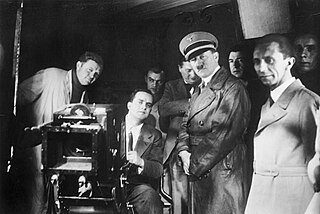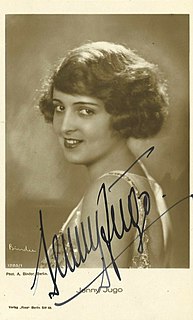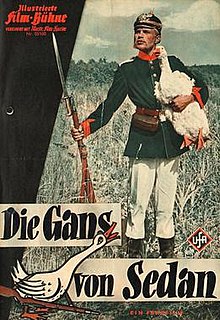
The film industry in Germany can be traced back to the late 19th century. German cinema made major technical and artistic contributions to early film, broadcasting and television technology. Babelsberg became a household synonym for the early 20th century film industry in Europe, similar to Hollywood later.
UFA GmbH, shortened to UFA, is a film and television production company that unites all production activities of Bertelsmann in Germany. Its name derives from Universum Film AG, which was a major German film company headquartered in Babelsberg, producing and distributing motion pictures from 1917 through to the end of the Nazi era. The name UFA was revived by Bertelsmann for an otherwise unrelated film and television outfit, UFA GmbH.

German Expressionism(cinema) consisted of a number of related creative movements in Germany before the First World War that reached a peak in Berlin during the 1920s. These developments in Germany were part of a larger Expressionist movement in north and central European culture in fields such as architecture, dance, painting, sculpture and cinema. This article deals primarily with developments in German Expressionist cinema before and immediately after World War I, approximately from 1910 to the 1930s.

Nazism created an elaborate system of propaganda, which made use of the new technologies of the 20th century, including cinema. Nazism courted the masses by the means of slogans that were aimed directly at the instincts and emotions of the people. The Nazis valued film as a propaganda instrument of enormous power. The interest that Adolf Hitler and his propaganda minister Joseph Goebbels took in film was not only the result of a personal fascination. The use of film for propaganda had been planned by the National Socialist German Workers Party as early as 1930, when the party first established a film department.

Erich Pommer was a German-born film producer and executive. Pommer was perhaps the most powerful person in the German and European Film Industries in the 1920s and early 1930s.
Women Are Better Diplomats is a 1941 German musical comedy film directed by Georg Jacoby and starring Marika Rökk, Willy Fritsch and Aribert Wäscher. It was based on a novel by Hans Flemming. The film was the first German feature film to be made in colour, and was one of the most expensive films produced during the Third Reich. The film met with a positive public response and was among the most popular German films of the early war years.
Das häßliche Mädchen is a German comedy film made in early 1933, during the transition from the Weimar Republic to Nazi Germany, and premièred in September that year. It was the first or second film directed by Hermann Kosterlitz, who left Germany before the film was completed and later worked in the United States under the name Henry Koster, and the last German film in which Dolly Haas appeared; she also later emigrated to the US. A riot broke out at the première to protest the male lead, Max Hansen, who was supposedly "too Jewish." The film's representation of the "ugly girl" as outsider has been described as a metaphorical way to explore the outsider existence of Jews.

Jenny Jugo was an Austrian actress. She appeared in more than fifty films between 1925 and 1950.
Prussian films were a cycle of historical films made in Germany during the Weimar (1918–1933) and Nazi (1933–1945) eras noted for their general glorification of Prussian history and its military. The films are set during the eighteenth and nineteenth centuries. They particularly focused on Frederick the Great, who ruled Prussia from 1740 to 1786 greatly expanding its territory. The films were extremely popular with German audiences and an estimated forty four were produced by the end of the Second World War.

The Bavaria Studios are film production studios located in Munich, the capital of the German region of Bavaria. They were constructed in the suburb of Geiselgasteig in 1919 shortly after the First World War. During their early years they were known as the Emelka Studios, while Geiselgasteig has also often been used to refer to them. They provided a provincial rival to the emerging dominance of Berlin studios, particularly the UFA conglomerate. Bavaria Film took over the studios, and became the dominant non-Berlin production company. While working on a co-production for Britain's Gainsborough Pictures, Alfred Hitchcock made his 1926 silent The Mountain Eagle on the Emelka stages.

Gabriela is a 1950 West German musical drama film directed by Géza von Cziffra and starring Zarah Leander, Carl Raddatz, and Vera Molnar. It was Leander's comeback film after a seven-year absence from filmmaking. In 1943 when the Nazi leadership had demanded she take German citizenship, she had broken her contract with UFA and returned to her native Sweden. In the immediate post-war era she was banned from appearing in German films because of her previous association with the Nazi hierarchy. From 1949 this was relaxed, and she was able to make films once more.

To New Shores is a 1937 German drama film directed by Detlef Sierck and starring Zarah Leander, Willy Birgel and Viktor Staal. It was Leander's first film for the German studio UFA, and its success brought her into the front rank of the company's stars. It was shot at the Babelsberg Studio in Berlin.

The Goose of Sedan is a 1959 French-West German comedy war film directed by Helmut Käutner and starring Hardy Krüger, Jean Richard and Dany Carrel. It was based on the novel Un Dimanche au Champ D'Honneur by Jean L'Hôte. The film was one of a growing number of co-productions between the two countries during the era. It was also released under the alternative title Without Trumpet or Drum.

S.O.S. Sahara is a 1938 German drama film directed by Jacques de Baroncelli and starring Charles Vanel, Jean-Pierre Aumont and Marta Labarr. The film was made in the French language, produced by the French subsidiary of the German studio UFA. It was shot on location in Algeria. The screenplay was based on a play Men Without a Past by Jean Martet. Martet's credit was removed from the film during the Nazi occupation of France, and he later brought a court case against UFA establishing his rights to the film.

Tobis Film was a German film production and film distribution company. Founded in the late 1920s as a merger of several companies involved in the switch from silent to sound films, the organisation emerged as a leading German sound studio. Tobis used the Tri-Ergon sound-on-film system under the Tobis-Klang trade name. The Ufa production company had separate rights to the Tobis system, which it used under the trade name of Ufa-Klang. Some Tobis films were released in Germany by the subsidiary Europa Film.
Ilse Kubaschewski (1907–2001) was a German film producer. She became one of the prominent figures in the post-war German film industry after setting up the distribution company Gloria Film in 1949.
Staaken Studios was a film studio located in Staaken on the outskirts of the German capital Berlin. A large former zeppelin hangar, it was converted to film use following the First World War and operated during the Weimar Republic. In July 1923 it was the largest studio in the world, with floor space of around 18,000 square feet. It was used for the construction of massive sets on a series of major productions of the silent era, including I.N.R.I., Metropolis, The Holy Mountain and The Ship of Lost Souls.

The Tempelhof Studios are a film studio located in Tempelhof in the German capital of Berlin. They were founded in 1912, during the silent era, by German film pioneer Alfred Duskes, who built a glass-roofed studio on the site with financial backing from the French company Pathé. The producer Paul Davidson's PAGU then took control and constructed a grander structure. The First World War propaganda drama The Yellow Passport, the historical comedy Madame DuBarry and the expressionist 1920 silent film The Golem were made there by PAGU.
The Johannisthal Studios were film studios located in the Berlin area of Johannisthal. Founded in 1920 on the site of a former airfield, they were a centre of production during the Weimar and Nazi eras. Nearly four hundred films were made at Johannistal during the silent period. Sometimes known as the Jofa Studios, in 1929 they became the base of the newly-established German major studio Tobis Film at the beginning of the sound era.











